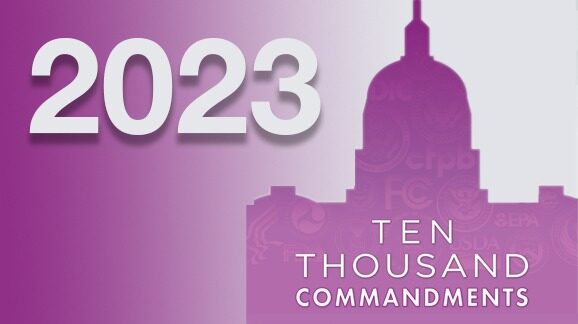Chapter 8: Another Dimension of Regulatory Dark Matter: Over 22,000 Agency Public Notices Annually
Along with presidential proclamations are those of departments and agencies. These are numerous and sweeping. Through various kinds of guidance documents, notices, and policy statements, government can signal expectations, specify parameters for, and influence various pursuits, including health care, retirement, education, energy production, finance, land and resource management, science and research, and manufacturing. These may not appear in the Federal Register at all.
A prominent Obama-era proclamation was the IRS’s granting of waivers of the Patient Protection and Affordable Care Act’s employer mandate, in defiance of statutory language. Playing a similar role today is Biden’s student loan forgiveness, but also the Department of Education’s quiet changing of eligibility rules on a website. Other prominent newcomers in the guidance world are the Federal Trade Commission’s guidance on disclosures for social media influencers and the “Policy Statement Regarding the Scope of Unfair Methods of Competition under Section 5 of the Federal Trade Commission Act.” The Department of Transportation in 2022 issued a copycat version, “Guidance Regarding Interpretation of Unfair and Deceptive Practices.”
The State Department, with 60 global partners, in 2022 launched the “Declaration for the Future of the Internet.” Similarly ambitious is the White House Office of Science and Technology Policy’s “Blueprint for an AI Bill of Rights: Making Automated Systems Work for the American People,” which also functions as prescriptive guidance. It notes that “[d]esigners, developers, and deployers of automated systems should take proactive and continuous measures to protect individuals and communities from algorithmic discrimination and to use and design systems in an equitable way.”
Post–CARES Act eviction moratorium extensions by both the Trump and the Biden administrations following the Coronavirus Aid, Relief, and Economic Security Act (CARES Act) were prominent dark matter regulations. A less attention-getting but noteworthy piece of dark matter is the “Notice of Federal Guidelines” from the National Highway Traffic Safety Administration on “Cybersecurity Best Practices for the Safety of Modern Vehicles.” Just four months later, in January 2023, the Federal Aviation Administration issued a ground-stop of air travel owing to a “damaged database file with no evidence of a cyberattack.” Similarly ineffective rules failed to prevent pipeline disruptions of East Coast fuel service during a May 2021 ransomware attack despite a preexisting dedicated Department of Energy “Emergency Response Organization.”
Federally directed electric vehicle charging networks and drone airspace management will likely be significantly governed by guidance. Washington is also pursuing government-run payment systems and a central bank digital currency, digital IDs, and other moves that allow government to remotely regulate without a law, without written regulations, without even formal guidance. Push-button regulation from a distance is enabled by the Internet of Things, seen already in the bipartisan infrastructure law’s requirement for future “passive monitoring” of vehicles.

As the House Oversight Committee detailed in the 2018 report “Shining Light on Regulatory Dark Matter,” agencies have issued at least 13,000 guidance documents since 2008. Only 189 had been submitted to both Congress and the Government Accountability Office, as required by the Congressional Review Act. At least 536 were significant, but only 328 were submitted to OMB for review.
Even the 13,000 documents agencies reluctantly reported to Congress are an undercount. Trump sought to address guidance in 2019’s Executive Order 13891, “Promoting the Rule of Law through Improved Agency Guidance Documents,” which established online portals and inventories at agency websites. Biden eliminated these portals and disclosures.
A count derived from this author’s August 2022 survey of agency portal remnants topped 107,000 entries. This partial tally would not have been possible without the Trump executive order. As it stands, disclosure could deteriorate, because the formal rulemakings on guidance procedures that Executive Order 13891 required of agencies have also been systematically eliminated by nearly all of the 32 departments and agencies that adopted them. At Biden’s behest, these agencies and departments wrote new rules to disavow and eliminate the nascent disclosures. Reporting of guidance or notices in the Federal Register was never reconciled with agencies’ guidance document portals before Biden’s eliminating the project.
In addition to the Federal Register’s final and proposed rules one often examines, certain public notices issued throughout the year appear in the Federal Register. Unlike the hard guidance documents the House Oversight Committee sought, these typically consist of nonrulemaking documents, such as meeting and hearing announcements and agency organizational material. But numbering in the tens of thousands, yearly public notices can also include memoranda, bulletins, guidance documents, alerts, and other proclamations that may be consequential to the public and may overlap with what would have materialized in a portal project carried to fruition.
Figure 17 depicts the number of notices published annually in the Federal Register, which peaked at over 26,000 in 2010 and 2011 (and are comparable to “Other” in Appendix: Historical Tables, Part B). Standing at 22,505 at the end of 2022, notices have dipped below 24,000 only eight times since 1996. The dips during the Trump “deregulatory” years have reversed. Although many notices may rightly be regarded as trivial, there have been 683,595 public notices since 1994 and well over 1 million since the 1970s. Even the trivial-seeming meeting notice announcements can implement progressive regulatory pursuits.
Increased unilateral executive and independent agency proclamations perpetrated by memorandum, notice, letter, bulletin, and other means all come atop traditional rules and regulations that are subject to minimal cost and burden disclosure. The fusion of heavy spending and federal regulatory interventions of recent years can be expected to lead to suspect guidance material, including the notices in Figure 17. Increased reliance on guidance and notices, if allowed, will render the effects of central government intervention and displacement of private activity even less transparent than they are already.
It is time to address federal guidance document disclosure in a comprehensive way. Given surges in government spending and programs concurrent with the hollowing of portals, guidance procedures, and OMB review of guidance, an unleashing of regulatory dark matter appears in the offing.
